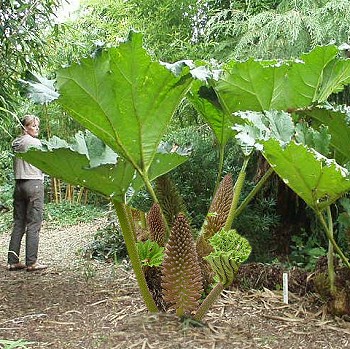
|
|
Giant
Gunnera with flowers ( Gunnera manicata)
|
Gunnera
- Gunnera spp.
Gunnera is a genus of herbaceous flowering plants, some of them
gigantic. The genus is the only member of the family Gunneraceae. This genus was named after the Norwegian botanist Johann Ernst
Gunnerus.
These perennials are mainly grown for their
beautiful foliage. Gunnera isn't hardy in very cold climates; they are natives of South
America, South Africa, Tasmania, Abyssinia, Java, New Zealand and Hawaii.
The 40-50 species vary enormously in leaf size.
There are actually two species, not easily told apart, that go by the common name Giant
Gunnera. Both can have individual leaves that are 4-6' across. (In the wild in their native
Chile, leaves may be 8-10' across.) The main difference between the two species is that
G. manicata is a little taller, to 8', while G. tinctoria is usually more like 6'
tall.
Gunnera manicata, native to the Serra do Mar mountains of southeastern
Brazil, is perhaps the largest species, with leaves typically 1.5-2 m (5-6 ft)
wide, but exceptionally long, up to 3.4 m (11 ft), borne on thick, succulent leaf stalks
(petioles) up to 2.5 m (8 ft) long. It germinates best in very moist, but not
wet, conditions and temperatures of 22 to 29 įC.
It grows slowly and produces
rounded,
lobed dull green leaves, which are heart-shaped at the base, on prickly leaf
stalks. The tiny, light green flowers grow in
conical spikes in early summer.
Only slightly smaller is Gunnera tinctoria of the Juan Fernandez Islands off the Chilean
coast. They can have leaves up to 2.9 m (9 ft 5 inches) in width on stout leaf stalks 1.5 m (5
ft) long and 11 cm (4.5 in) thick.
Gunneras are native to the cloud forests of the Andes. Cloud forests are forests socked in by
clouds. This means there is a lot of shade.
Although they are in the tropics, the cloud forests, being up high with the
clouds, are much more moderate in both temperature humidity than the jungles
below.
Gunneras therefore are adapted for moderation in these factors.
Another famous
species of Gunnera is Gunnera insignis, more commonly known as "Sombrilla de
Pobre" (umbrella of the poor). It is a native of the rain forests of Central America and South
America. This plant is found in the cloud forest of Volcano Poas of Costa Rica. It's called the Poor Man's Umbrella because back in the day this plant was used by the workers in the fields as an umbrella due to it's strong leaf covering and
size.
Gunneras grow in in seepage areas, near
springs, rivers, and lakes where there is a constant, unlimited supply of water. Just look at those leaves and imagine how much water they can
transpire. That means a lot has to be coming in at the roots. Note also how the leaves are shaped and positioned on the
plant. These huge leaves act as funnels, bogarting all the rain and funneling it right to the middle of the
plant.
Gunneras
are edible.
Young leaf stalks can be peeled and
cooked as a vegetable or eaten raw. They are "Acidic and refreshing". In Southern Chile
G. tinctoria is a delicacy associated
with Mapuche Indian customs. The young petioles are commonly sold by street
vendors and eaten raw, along with salt and chilli to enhance the flavour
G.
tinctoria also has medicinal uses as an astringent. This species can also be
used as to make a black dye is obtained from the root, and has been used as a
roof covering.
Source:
http://en.wikipedia.org/wiki/Gunnera
http://www.botany.com/gunnera.html
http://www.pfaf.org/database/plants.php?Gunnera+tinctoria
http://worldplants.com/gunnera.htm
